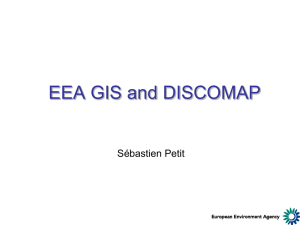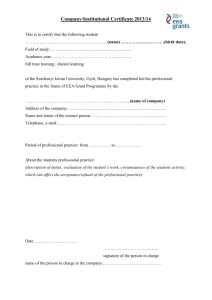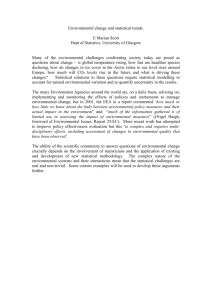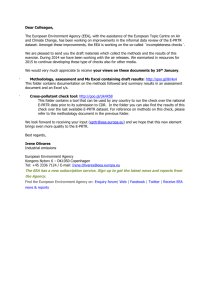Some common Causes, Consequences and Solutions to the 3 crises
advertisement
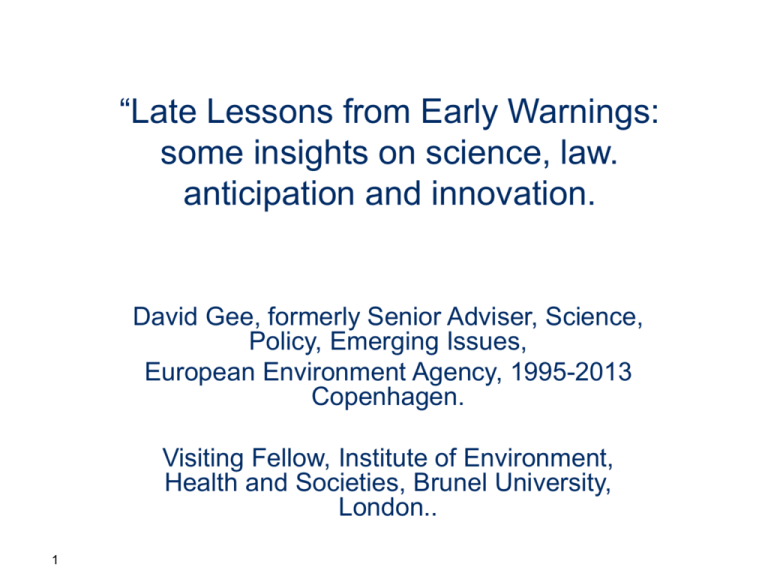
“Late Lessons from Early Warnings: some insights on science, law. anticipation and innovation. David Gee, formerly Senior Adviser, Science, Policy, Emerging Issues, European Environment Agency, 1995-2013 Copenhagen. Visiting Fellow, Institute of Environment, Health and Societies, Brunel University, London.. 1 Institute of Environment, Health and Societies, Brunel University A case for creating a new Nobel Prize in Transdisciplinary Science David Gee Genevieve Dewez Susan Jobling Institute of Environment, Health and Societies Environmental facts are not neutral.. ..”the process of finding facts is always driven by a particular purpose, and you should reflect on what those purposes are in evaluating environmental laws” Prof Liz Fisher, Oxford University, in “Environmental Law: Text, cases and Materials”, 2013. 5 “Structured knowledge”: frameworks of understanding. A response to: • • • • • • “information overload” “Data rich, knowledge poor” societies Ecosystems complexity Biological complexity Socio-political complexity An added value niche for the EEA Exs of SK: DPSIR; SOER; “Late Lessons from Early Warnings” reports. 8 The “Late Lessons from Early Warnings” reports, 2001, 2013 • Contents, approach, conclusions • Inertia and innovation in Scientific knowledge • Some case studies • Precaution, Evidence, Innovation • Radical & “responsible innovation”? Homo Sapiens (tragicus?) as slow learners Two volumes 2001 2013 34 case studies ‘Environmental chemicals’ • Beryllium • PCBs • CFCs • TBT antifoulants • Mercury • Environmental Tobacco • Perchlorethylene • Booster biocides • DBCP • DDT • Vinyl chloride • Bisphenol A Ecosystems • Ecosystems resilience • Great Lakes pollution • Fish stock collapse • Acid rain • Bee decline, France • Invasive alien species • Floods • Climate change Transport fuel additives • Benzene • MBTE • Lead ‘Micro technologies’ • Nano • GMOs Animal feed additives • BSE, ‘mad cow disease’ • Beef hormones • Antibiotics • Asbestos Pharmaceuticals • Contraceptive pill • DES Radiations • X-rays • Mobile phones • Nuclear accidents Plus 8 “horizontal “ chapters…. • the “12 late lessons” from vol 1… ..and in vol 2: • precautionary science; • costs of inaction; • the precautionary principle; • false positives • protecting early warners & late victims; • why businesses ignore early warnings; • Conclusions. When was first plausible early warning? 1896 radiation; climate change; 1897 benzene; 1898 asbestos; 1925 leaded petrol; 1965 antibiotics in animal feed; 1992/3 Goucho pesticide and bee decline; 1999 mobile phones Why are early warnings routinely ignored? • • • • • • • • • Powerful economic/political stakes in status quo Unethical behaviour, e.g. greed “We don’t want to know” / “Don’t spoil the party” Early warners sidelined or silenced Uncertainties lead to real and “manufactured” doubt “Group think” Lack of Imagination Limited use of scenarios “Things are different now”* See also “Collapse”, J. Diamond, 2005 ; “The March of Folly”, B Tuchman, 1984; “Fishing for Truth”, Finlayson,1994; “Sustainability or Collapse?”, Costanza et al 2007; “A users guide to the Crisis of Civilisation and how to save it”, Ahmed;2010 *“This time its different : 8 Centuries of Financial Folly” Reinhart & Rogoff,2009. 18 “Manufacturing Scientific Doubt” “Doubt is our product since it is the best means of competing with the ‘body of fact’ that exists in the mind of the general public.” From an executive at Brown & Williamson, Tobacco Company, 1969. See EEA chapters on Beryllium,tobacco, leaded petrol, climate change etc. And Michaels 2009: Oreskes,2010 on manufacturing doubt. Late Lessons from Vol 1 • “Acknowledge & respond to ignorance as well as uncertainty and risk • Provide adequate research and long term monitoring into early warnings • Account for real world conditions • Take full account for assumptions & values • Adopt diverse and adaptable technologies to minimise costs of “surprises” and maximise benefits of innovation” • Plus 5 others…. 21 Late Lessons from vol 2.. • Give more weight to natural, human, & social capitals than economic/financial capital via more use of precaution, prevention, control at source and polluter pays principles (EU Treaty) • Acknowledge complexity & multi-causality when inferring causality • Use lower strengths of evidence for precautionary actions • Seek & use lay, local, professional knowledge & citizen science • Develop broader more transparent risk assessments • Build more effective, adaptable, participatory and cooperative systems of governance of innovation. 22 Need for greater public engagement • In hazard/risk/options/alternatives assessments • In choosing strengths of evidence for action & “acceptable” risk • In choosing strategic innovation pathways to 2050 on energy, agriculture,& consumer chemicals. • In nature & directions of research: eg the product/ hazard ratio “Misplaced Certainties” of safety .. …were a dominant cause of tragedy in the Late Lessons case studies…. ..similar to elsewhere in science… and medicine: “Chalmers identified the variety of strategies of persons who derived their authority from power rather than knowledge…to discredit studies that yield results that challenge their certainties” Fox D.M. on the strong influence on clinicians of Chalmers et al in publishing the systematic review ,”Effective Care in Pregnancy & Childbirth”, 1989; in “Systematic Reviews and Health Policy”, Milbank Quarterly, v 89,3,2011. Casual and self interested science even within clinical medicine…….. “some scientists have a remarkably casual attitude to…evidence..drawing conclusions..based more on factors such as their gender and how they make a living than on the ..evidence” ..disguising their bias and self interest in the rhetoric of science” Chalmers et al in “Effective Care in Pregnancy & Childbirth”, 1989. Exposures always expand over time… • Asbestos/DBCP/Be producers, users, bystanders eg insulators: plantation workers: passive smokers • Domestic: wives & children of asbestos workers; passive smokers • Environmental: near asbestos & lead mines and factories; teachers from asbestos; DBCP in plantation workers & water; • Consumers: BPA • Next generations: radiations, Mercury at Minamata, DES, PCBs • Target to non target species: Goucho & Bees;; oysters from TBT; fish from the Pill; The Nature of Harm always expands over time… • Asbestos: 1929 asbestosis; 1954 lung cancer; 1959 mesothelioma, 2012 throat & other cancers • Tobacco: 1951 lung cancer; 2012 many cancers, foetal harm; heart disease • PCBs: 1960s bird reproduction;2012s neurological harm in children; soil contamination • Lead: 1979 brain damage in children; 2012 heart disease in adults • Minamata: 1950 brain damage & neurological; 1960s birth defects 1990s children’s IQ & behavioural • DES: 1970 vaginal cancer; 1980s reproductive problems; 2012 breast cancer; reproductive harm to DES sons; and to grandchildren (“Late Lessons” vol 1 update, 2013) And harm is always found to be caused at lower & lower levels of exposure… • • • • • • • • Asbestos (no safe level,2001,WTO) Lead (“no safe level”, EFSA ,2010) PCBs Mercury TBT Radiations BPA Benzene…& others. Observing, inferring, & understanding scientific revolutions…and time. 1854 Snow’s reliable observation and inference about polluted water causing cholera… 1885 Koch provides the mechanistic understanding….for Snow’s observations and inference. Most case studies have similarly long gaps between robust observations & accepted understanding (tobacco, DES, leaded petrol) Timely precaution requires action on reliable observation & inference before there is understanding about how causality works…. ……..this is a value choice Expect inconsistency from variability "Consistency in nature does not require that all, or even a majority of studies find the same effect. If all studies of lead showed the same relationship between variables, one would be startled, perhaps justifiably suspicious“ Needlemann (1995) ”Making Models of Real World events: the use and abuse of inference, Neurotoxicology and Teratology, vol 17, no. 3. “No evidence of Harm” is not the same as “evidence of no harm”…… ...because no relevant or reliable research is available, ..or because of the limitations on what could be known with existing scientific methods, under complexity and multicausality; and ...ecological/biological effects can take a very long time to appear. Research: how much on developing products v on anticipating hazards? EU Public Research 1994-2013 “Products” “Protection” Nanotechnology (20022013) 5 billion 112 million (2%) Biotechnology(19942013) 7.5billion 273 million (4%) Information Communications Technology/EMF(20072013) 19 billion 18 million (0.09%) Scientific Inertia in chemicals research • There were 15,000 articles published between 2000-2009 on lead, mercury and DDT alone. • Only 352 articles researched 8 of the 13 emerging, large production chemicals identified as priorities by the US EPA, eg 1,3-Dichlorobenzene. • There were no articles on five other priority chemicals. Some case studies 50 UK Court of Appeal on foreseeability of mesothelioma…..1996 “Liability would arise where the applicant should reasonably have foreseen a risk of some pulmonary injury, not necessarily mesothelioma” Owen McIntyre,in “Protecting early warners & late victims” Carl Cranor, LLEW, EEA,2013 56 The DBCP pesticide: An early warning…1958 “We understand that Dow chemical have similar data (testes shrunk and sterility in rats) and we are very upset by the effects noted on the testes” Lykken, Shell, See “The pesticide DBCP and male infertility”, Bingham E, Monforton, C., in Late Lessons, EEA,2013 Effects of DBCP on Plantation workers . • 16, 000 S American plantation workers get /don’t get compensation, 1990s -2010. • Dole Co tries to ban Swedish documentary “Bananas”, but fails after widespread outcry,2009/10 • US court awards costs and freedom to screen,2010 • “Big boys gone Bananas” film, 2011, about that episode. 2013: Environmental pollution from DBCP • The early warning: “DBCP’s relatively low vapour pressure and high density assures a long residence time in the soil” depending on method of application. (Torkelson,1961) • Widespread DBCP water contamination of IARC possible carcinogen (1999) in California & elsewhere: 191 water systems in 18 US States above exposure limit of 0.2ppb. Climate Change • Arrhenius (1896) estimated that a doubling of the quantity of CO2 in the atmosphere would raise the average global temperature of about 5°C. • The US National Academy of Sciences report on global warming (Charney et al.,1979) concluded that the impact of doubled atmospheric CO2 concentrations, would increase global mean equilibrium surface temperature increase of between 1.5°C and 4.5°C. • Largely confirmed by IPCC in 2007 & 2014: likely range 2.0 to 4.5°C. 69 Climate Change not a priority for CEOs • Climate change did not make the first 19 top priorities for concern…… • Top priority was “over regulation”………. PricewaterhouseCoopers 18th annual CEO survey, 2015. Willfull blindness? Institutional stupidity? Economic/Political short termism? “Now, under my administration, America is producing more oil today than at any time in the last eight years. Over the last three years, I’ve directed my administration to open up millions of acres for gas and oil exploration across 23 different states. We’re opening up more than 75 percent of our potential oil resources offshore. We’ve quadrupled the number of operating rigs to a record high. We’ve added enough new oil and gas pipeline to encircle the Earth and then some.” Obama, Cushing, Oklahoma, 2013. 75 76 The early warning on Leaded petrol at the one day “trial” of leaded petrol, May 1925 “conditions will grow worse so gradually , and the development of lead poisoning will come on so insidiously ..that leaded petrol will be in nearly universal use..before the public and the government awakens to the situation.” Yendell Henderson, Professor of Physiology at Yale. “Universal use” became global: & the public awakening took some 60 years…. “Lead makes the mind give way: lead in petrol” Needleman & Gee, Late Lessons, EEA, 2013 US Law helps to ban leaded petrol… • “the regulatory action under this precautionary statute (Clean Air Act 1970 ) should precede and hopefully prevent the perceived harm” • Action is needed at the “frontiers of scientific knowledge” • The EPA is “not required to limit the danger from just lead additives but to the cumulative impact of lead additives with other sources of human exposure to lead” 82 Costs of Leaded petrol 2013 • Multi biological impacts in children and adults with no safe level (EFSA 2010) • Costs mainly from lost lifetime productivity from reduced IQ in children• Current estimate is 1.5 Euro per gram of lead/litre in urban areas from petrol • Giving annual costs of 4-6% GDP over the leaded years. See “Costs of inaction” Skou Andersen and Clubb; EEA ,2013. Early Warning scientists personally harassed for their “inconvenient truths” • • • • • • • • • Snow on Cholera Selikoff on asbestos Hendersen, Byers, Patterson, Needleman on leaded petrol Henry Lai, Hardell on RF radiation Putzei, Chapella, Seralini on GMOs Dr Hosakawa on Minamata Schneiderman on Climate Change others from Bees research Onur Hamzaoglu on industrial pollution in Turkey • Dr Stockman in Ibsen’s “An Enemy of the People” (See case study chapters & “Justice for early warners & late victims”, Cranor, in “Late Lessons” EEA , 2013) Flawed Risk Assessments on neonicotinoid pesticides and Bees • Wrong risk regime: ie for sprayed not sytemic pesticides. • “Low” exposures to bees assumed to be safe. • On Acute effects on bees only cf sub-lethal, chronic and colony level effects. • Neglect of systemic effects within hives cf bees • Inadequate evaluation of multi-causality and complexity. • No/little representation of beekeepers & relevant academic researchers • Independent critiques of RAs need data access & transparent evaluations: but these not available the futile search for the single cause..of all impacts on bees.. at all levels!? “The Risk Assessment does not allow us to demonstrate that maize seed dressing with Gaucho can be solely responsible, at national level, for all colony losses, behavioural troubles, honey bee mortalities, or general decline in honey production” French Commission for Toxic Products , 2002: see “Seed dressing systemic insecticides and honeybees”, Maxim L. & van der Sluijs,J., Late Lessons from Early Warnings, EEA 2013. or embrace multi-causality….? “Gaucho…is of concern (on maize) as one of the explanatory elements for the weakening of the bee populations observed despite the ban of Gaucho in sunflowers.” Multifactor study of the Honeybee Colonies Decline, French Scientific & Technical Committee, 2003, see Late Lessons, Bees chapter Regulatory Science does not keep pace with technological innovation… “the new generation of neonicotinoids was first marketed in France in 1993, and new methods for assessing their new risks for honeybees are still not in regulatory use today!” Laura Maxim, co-author of the Bees chapter, 2014 “Lowe's (USA) to eliminate pesticides that hurt crop pollinating honeybees” Reuters, April 2015 98 Precaution, Evidence, Innovation 99 ‘The Irish Potato Famine and Precaution-1846 "Are you to hesitate in averting famine which may come, because it possibly may not come? To consider and calculate how much diarrhoea, and bloody flux, and dysentery, a people can bear before it become necessary for you to provide them with food? Is it not better to err on the side of precaution than to neglect it utterly?" Sir Robert Peel, UK Parliament, 27 March 1846 100 Many definitions of the PP • See PP chapter in Late Lessons for 13 definitions. • Common elements of justifying action to reduce harm in face of scientific uncertainty • But: no explicit clarification of the standard of evidence needed to justify action… • And sometimes couched in triple negatives eg Rio definition..and • The context, case specificity of actionable evidence, and proportionality of actions are only implicit.. The EEA working definition of the Precautionary Principle based on “Late Lessons” experiences “The PP provides justification for public policy actions in situations of scientific complexity, uncertainty and ignorance, where there may be a need to act in order to avoid, or reduce, potentially serious or irreversible threats to health or the environment, using an appropriate strength of scientific evidence, taking into account the likely pros and cons of action and inaction”. Chapter 27, Late Lessons ,2013. Some Strengths of Scientific Evidence…. • • • • • • • 106 Beyond all reasonable doubt (scientific causality & criminal law) Reasonable certainty (Int.Panel Climate Change , 2007) Balance of probabilities/evidence (IPCC,2001; civil law) Strong possibility (IARC on ELF ,2002; on RF 2011) Reasonable grounds for concern(EU Communication on PP) Scientific suspicion of risk (Swedish Chemicals Law,1975) “Pertinent information” (WTO justifying member state actions to protect health) More Precaution needed with Neurotoxins & Endocrine Disrupting Chemicals because .. • lessons from the past tragedies with EDCs (Lead, Mercury,TBT,DES) • Complexity & multi-causality delays “sufficient” knowledge of harm... • And fast technological change overtakes.. • ..the slow increase in scientific knowledge • Plausible evidence of delayed & serious impacts is now available • ..requiring exposure reductions based on “low” strengths of evidence Cost & benefits of false positives Costs : • Mainly economic, • Action on Swine Flu had serious health effects from reactions to the vaccinations: and wasted resources due to bad planning Benefits • Sparked innovation within industry, government and scientific research • Swine flu lead to a nation-wide disease surveillance program and a lot was learned about whole and split vaccines • Labelling of saccharin lead to the development of several new artificial non-calorific sweeteners Use of the Precautionary Principle stimulates innovation by: • bringing forward by years /decades the innovations that were stimulated by the late regulatory actions • stimulating debate & action on wider technological & social options for meeting needs • saving billions in damage costs that could have been spent on innovation. Benefits of action expands over time… • CFCs: from ozone “hole” to Climate Change benefits • TBT: from local to global benefits • PCBs: action to gain wildlife benefits brought some health benefits • Lead: action to protect children’s IQ reduced some adult heart disease Barriers to Precautionary Action: Policy • Inadequate/conflicting risk assessments • Market failures ie costs of harm externalised onto society • Corporate incentives & power; “manufactured doubt”; control of research (leaded petrol, GMOs) • “Regulatory capture” • Short termism • “Losers” mobilise, “gainers” do not • “Willfull Blindness” (Barbara Tuchman) • “Institutional stupidity” (Noam Chamsky) Stupidity & “Institutional Stupidity” “relying on unexamined assumptions, entrenched mental habits, or poor reasoning” (“Philosophy Now” Award for “Contributions to the Fight Against Stupidity”) “Institutional stupidity is stupidity which is nevertheless rational within the framework within it operates.” eg “The Rationality of Collective Suicide”, Chomsky,1986 N Chomsky, winner 4th Phil. Now Award, April, 2015 125 Responsible Innovation? Responsible Innovation: adaptable technologies with a social purpose…? • Expect “surprises” so promote diverse, robust, adaptable, technologies” (EEA,2001) • Promote responsible research & innovation for social purposes (EEA,2013) • With public engagement in choosing strategic innovation pathways to 2050 eg on food, energy. • Avoid technological lock in and pathway dependence • Promote “midstream modulation” of innovation pathways “Innovations for peoples and planet more than for patents, profits and power” (Gee,2014) Some moves toward responsible innovation • EU Code for responsible nano sciences & technologies • Socio-technical integration research programme: social scientists in labs looking at “midstream modulation” of research in line with social & ethical values • Value sensitive design • Constructive technology assessment • Green chemistry Which innovation pathway to feed the world? “Hungary for Innovation: from GM crops to agro-ecology” Chapter 19 ,”Late Lessons”, 2013. 132 Should Nuclear be on the innovation pathway to provide & save energy ? “Late Lessons from Chernobyl, early warnings from Fukushima” Chapter 18 “Late Lessons “ ,2013 Or Fracking……? See call for Fracking moratorium from House of Commons Env. Audit Comm., Mar 2015. 137 CFCs: Is “one molecule along” chemical innovation wise? “more money is now needed to phase out HCFCs.. It would surely have been better to stimulate more radical changes in technology from the outset…. ….focused on prudent long term goals..of halocarbon-free and energy efficient technologies” Joe Farman, Late Lessons, 2001, p 81. Limits to current “Growth” Model ? “Shapiro recognizes the world as a closed system whose limits are already pushing in on us..” “If we grow by using more stuff, I'm afraid we'd better start looking for a new planet.“ Shapiro, Monsanto ,1997, Fortune April 14. Who looks after the Long term in Democracies? • • • • • • • Politicians? Stock markets? Most Businesses? Appointed judges? Insurance companies? Long mandate Sustainability Commissions? Ombudsman/Committees for the Future? Eg Finland, New Zealand See “Taking the longer view” Roderick, 2010, Foundation for Democracy and Sustainable Development. Thank you geedavid90@gmail.com All chapters from both volumes of Late Lessons available from EEA website: paper copies from EU Publications office. Kindle version of vol 2 from EEA website


